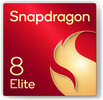Qualcomm Snapdragon 8 Elite vs Qualcomm Snapdragon 8 Elite for Galaxy
Qualcomm Snapdragon 8 Elite
► remove from comparison
The Snapdragon 8 Elite (SM8750-AB) is a high-end SoC for flagship smartphones and tablets in 2025 and the top product from the US manufacturer.
For the first time, Qualcomm is using CPU cores in smartphone SoCs that are not adapted ARM designs, but have their own ARM-based architecture: The manufacturer calls the processor part a second-generation Oryon CPU.
The previously used efficiency cores are no longer required and their task is taken over by the performance cores which, according to the manufacturer, are now flexible and efficient enough for this purpose.
There are a total of 2 prime cores with up to 4.32 GHz for complex tasks, which according to Qualcomm can also be overclocked at times. there are also 6 performance cores for less demanding tasks, which clock at up to 3.53 GHz.
Both processor clusters have 12 MB of L2 cache, which should offer low latency despite its size. Next up in the cache hirachy is a 8 MB SLC L3 cache and finally four 16 Bit LPDDR5x memory controllers to the main memory.
A new Adreno 830, which has also been redesigned, is used as the GPU. Thanks to the so-called "sliced architecture", it now offers three processing cores with a clock speed of up to 1.1 GHz.
Compared to the Snapdragon 8 Gen. 3, Qualcomm promises a processor speed advantage of up to 45% and similar efficiency gains. With the GPU, performance gains of up to 40% should be possible.
The focus for the 2025 flagship smartphones is also on AI. The new Hexagon NPU should offer 45% more performance compared to its predecessor and also work 45% more efficiently. There is also broad support for multimodal generative AI models.
The three ISPs have also been revised and are now called Spectra AI ISP. They can handle data from up to 3 48-megapixel cameras simultaneously. A resolution of up to 320 megapixels is possible with a single camera. Unlimited semantic segmentation is possible with 4K images, meaning that as many different layers and objects can be distinguished as there are in the image. This allows automatic photo optimization to be improved. In addition, the NPU now has direct access to the RAW data from the sensors for the first time.
The integrated Snapdragon X80 Modem-RF 5G system allows simultaneous transfers of 5G-mmWave and 5G-Sub6, enabling data rates of up to 10 GBit/s in download and up to 3.5 GBit/s in upload. The modem is also able to support all globally known 5G bands. Qualcomm's FastConnect 7900, which supports Bluetooth 6.0 and Wi-Fi 7, is responsible for local communication.
The SoC is manufactured at TSMC using the state of the art 3 nm process.
Qualcomm Snapdragon 8 Elite for Galaxy
► remove from comparison
The Snapdragon 8 Elite for Galaxy is a high-end SoC for Samsung's flagship smartphones and tablets of 2025.
For the first time, Qualcomm is using CPU cores that are not adapted ARM standard designs, but have their own ARM-based architecture: The manufacturer calls the processor part second-generation Oryon CPU. The previously used efficiency cores are no longer required and their task is taken over by the performance cores, which, according to the manufacturer, are now flexible and efficient enough for this purpose. The differences to the conventional Snapdragon 8 Elite are reflected in a slightly higher performance. The prime cores, GPU and NPU clock slightly higher.
There are a total of 2 prime cores with up to 4.47 GHz, which according to Qualcomm can also be overclocked at times. 6 performance cores for less demanding tasks are also installed, clocking at up to 3.53 GHz. Both processor clusters have 12 MB L2 cache, which should offer low latency despite its size. In the next stage, an 8 MB SLC L3 cache awaits the data before it has to go to the main memory via four 16-bit LPDDR5x memory controllers.
The GPU is the Adreno 830 GPU is used, which has also been redesigned. Thanks to the so-called "sliced architecture", it now offers three computing cores with a clock speed of up to 1.2 GHz.
The focus for the 2025 flagship smartphones is also on AI. The new Hexagon NPU is said to offer 45% more performance compared to its predecessor and also work 45% more efficiently. There is also broad support for multimodal generative AI models.
The three ISPs have also been revised and are now called Spectra AI ISP. They can handle data from up to 3 48-megapixel cameras simultaneously. A resolution of up to 320 megapixels is possible with a single camera. Unlimited semantic segmentation is possible with 4K images, meaning that as many different layers and objects can be distinguished as there are in the image. This allows automatic photo optimization to be improved. In addition, the NPU now has direct access to the RAW data from the sensors for the first time.
The integrated Snapdragon X80 Modem-RF 5G system allows simultaneous transfers of 5G-mmWave and 5G-Sub6, enabling data rates of up to 10 GBit/s in download and up to 3.5 GBit/s in upload. The modem is also able to support all globally known 5G bands. Qualcomm's FastConnect 7900, which supports Bluetooth 6.0 and Wi-Fi 7, is responsible for local communication.
The SoC is manufactured at TSMC using the 3 nm process (N3E).
| Model | Qualcomm Snapdragon 8 Elite | Qualcomm Snapdragon 8 Elite for Galaxy | ||||||||||||||||
| Codename | Oryon Gen 2 | Oryon Gen 2 | ||||||||||||||||
| Series | Qualcomm Snapdragon 8 | Qualcomm Snapdragon 8 | ||||||||||||||||
| Series: Snapdragon 8 Oryon Gen 2 |
|
| ||||||||||||||||
| Clock | 3530 - 4320 MHz | 3530 - 4470 MHz | ||||||||||||||||
| L2 Cache | 12 MB | 12 MB | ||||||||||||||||
| L3 Cache | 8 MB | 8 MB | ||||||||||||||||
| Cores / Threads | 8 / 8 3 x 2 x 4.3 GHz Qualcomm Oryon Gen 2 Prime 6 x 3.5 GHz Qualcomm Oryon Gen 2 Performance | 8 / 8 3 x 2 x 4.5 GHz Qualcomm Oryon Gen 2 Prime 6 x 3.5 GHz Qualcomm Oryon Gen 2 Performance | ||||||||||||||||
| Technology | 3 nm | 3 nm | ||||||||||||||||
| Features | Adreno GPU, Spectra ISP, Hexagon, X80 5G Modem, Wi-Fi 7, LPDDR5x 4800 | Adreno GPU, Spectra ISP, Hexagon, X80 5G Modem, Wi-Fi 7, LPDDR5x 4800 | ||||||||||||||||
| iGPU | Qualcomm Adreno 830 ( - 1100 MHz) | Qualcomm Adreno 830 ( - 1100 MHz) | ||||||||||||||||
| Architecture | ARM | ARM | ||||||||||||||||
| Announced | ||||||||||||||||||
| Manufacturer | www.qualcomm.com | www.qualcomm.com |
Benchmarks
Average Benchmarks Qualcomm Snapdragon 8 Elite → 100% n=22
Average Benchmarks Qualcomm Snapdragon 8 Elite for Galaxy → 105% n=22
* Smaller numbers mean a higher performance
1 This benchmark is not used for the average calculation













